South Africa is grappling with a significant economic challenge as the United States imposes a 30 percent tariff on South African exports starting August 7, 2025. This tariff threatens to severely disrupt trade relations, trigger job losses across key industries, and pressure national economic growth.

Major export-driven sectors—including agriculture, manufacturing, automotive, textiles, and mining—are bracing for impact. While the situation presents serious short-term risks, it may also push industries and policymakers toward long-term economic transformation.
Summary Table: Job Loss Crisis After 30% US Tariff
| Category | Details |
|---|---|
| Tariff Implementation Date | August 7, 2025 |
| Tariff Rate | 30% on US-bound South African exports |
| Most Affected Sectors | Agriculture, Manufacturing, Mining, Automotive, Textiles |
| Estimated Job Risk | Over 3 million combined across five sectors |
| Government Actions | Negotiations, financial aid, trade diversification, stimulus packages |
| Potential Markets to Target | Asia, Europe, SADC, African Continental Free Trade Area (AfCFTA) |
| Official Site for Trade Info | https://www.thedtic.gov.za |
Trade Shock: How the 30% US Tariff Affects South Africa
The sudden imposition of a 30 percent tariff on South African goods by the US has prompted concerns among economists, manufacturers, and workers. South Africa exports billions of rands worth of goods to the US annually, making the American market one of its most important trading partners.
With the new tariff, South African goods become significantly more expensive for US buyers. This could lead to contract cancellations, reduced demand, and production scale-backs—resulting in layoffs across several export-heavy industries.
Key Economic Sectors at Risk
| Sector | Export Value | Employment Impact |
|---|---|---|
| Agriculture | R20 billion | 850,000 workers |
| Manufacturing | R35 billion | 1.2 million workers |
| Mining | R15 billion | 450,000 workers |
| Automotive | R12 billion | 300,000 workers |
| Textiles | R8 billion | 200,000 workers |
These sectors are foundational to South Africa’s economy. A major disruption could have cascading effects on household incomes, small suppliers, and national GDP.
Exporters Begin Strategic Shifts
In the face of this challenge, some South African exporters are already adopting adaptive strategies to mitigate the damage:
- Market Diversification: Companies are targeting emerging markets in Africa, Asia, and Europe to reduce dependence on the US.
- Product Upgrading: Focusing on value-added, premium, and niche products to remain competitive despite higher tariffs.
- Regional Trade Expansion: Leveraging intra-African trade agreements to boost exports within the continent.
- Innovation Investment: Companies are accelerating R&D to enter less price-sensitive markets.
Though these strategies require time, they reflect a commitment to resilience and transformation within South Africa’s export ecosystem.
Government Response and Mitigation Efforts
The South African government, through the Department of Trade, Industry and Competition (DTIC), is actively working to cushion the blow:
- Diplomatic Engagement
South Africa is pursuing negotiations with US authorities to reverse, reduce, or delay the tariff implementation. - Emergency Financial Aid
The government is planning grant packages, tax incentives, and low-interest loans for businesses in affected sectors. - Domestic Manufacturing Stimulus
There is a push to increase demand for locally produced goods, reducing the reliance on imports and stimulating job creation. - AfCFTA Utilization
South Africa aims to strengthen trade relations across Africa, utilizing agreements under the African Continental Free Trade Area to open new markets.
These measures are expected to support exporters and preserve jobs, though their success will depend on timely implementation and private sector collaboration.
The Road Ahead: Can Industries Adapt?
Though the short-term picture appears grim, long-term resilience is possible if both government and industry act decisively. Key priorities include:
- Adopting automation and smart agriculture to reduce production costs
- Accelerating green transitions, such as producing electric vehicles and organic food
- Supporting small businesses and startups in textiles, agribusiness, and technology
- Deepening regional supply chains within SADC and broader African economic zones
These forward-looking strategies could drive inclusive growth and prepare the country to withstand future trade shocks.
How the Tariff Affects Everyday South Africans
The 30% tariff may have a direct and indirect effect on South African households:
- Job Loss Risk: Especially in factories and farms dependent on US contracts
- Rising Prices: Inflation could be triggered if businesses increase prices to offset losses
- Consumer Uncertainty: A sluggish economy could dampen wage growth and spending
However, there is hope. If the government successfully diversifies trade routes and boosts local production, price stability and job preservation are possible. Much will depend on how fast policies are implemented and whether businesses can realign.
Frequently Asked Questions (FAQs)
Q: Which sectors are most affected by the US tariff?
A: Agriculture, manufacturing, mining, automotive, and textiles—especially those with high US export volume.
Q: What actions is the South African government taking?
A: They are negotiating with US authorities, offering financial relief to affected sectors, and encouraging trade within Africa.
Q: Can South Africa shift exports to other regions quickly?
A: Yes. Markets in Africa, Asia, and Europe are being considered as alternative destinations.
Q: Will this lead to higher prices for consumers?
A: Possibly. Increased production costs may lead to inflation, but subsidies and local sourcing initiatives could help offset the impact.
Q: What is the long-term solution?
A: Building trade diversity, boosting local manufacturing, investing in innovation, and deepening intra-African trade relationships.
Official Resources
- Department of Trade, Industry and Competition (DTIC):
https://www.thedtic.gov.za - South African Revenue Service (Customs & Trade):
https://www.sars.gov.za - AfCFTA Information Portal:
https://www.au-afcfta.org
Final Thoughts
South Africa’s economic landscape is being reshaped by global trade dynamics. The 30% US tariff, effective in August 2025, poses a serious threat—but it also presents a critical opportunity for transformation.
With decisive government action and adaptive strategies from the private sector, this crisis could catalyze a stronger, more diversified export economy, ready to thrive beyond traditional markets.
For More Click HERE

